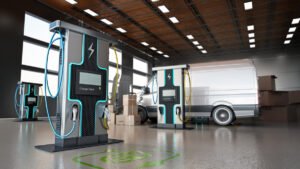The supply chain is undergoing a sustainability revolution. Organizations conscious of their green credentials are investing in electrification to reduce their carbon emissions. Electric vehicles (EVs) play a vital role in transitioning from fossil fuels to clean energy because e-mobility will change how people and goods reach their destinations.
How does the supply chain leverage EVs and batteries to prepare for a decarbonized future? What technologies do businesses use to take advantage of the opportunities electrification brings? What are the challenges and setbacks they face?
Here are the answers to these big questions.
What are the current challenges for Supply Chain Companies using EVsI
Of course, the automotive industry and its product cycles are mainly affected, but battery EVs (BEVs) and fuel cell EVs (FCEVs) are also becoming increasingly important in traditional supply chain processes.
Establishing a Circular Economy
The status quo of material availability doesn’t inspire EV battery supply-chain resilience. Only a few countries have control over the metals used in popular battery material chemistries.
For example, the Democratic Republic of the Congo has a monopoly on cobalt, accounting for more than 70% of the element’s supply. China’s ownership of 80% of the country’s cobalt output raises geopolitical risk. 2 of the top 3 lithium producers in terms of market capitalization are headquartered in China
Auto interests and policymakers understand that over-relying on mining to source raw materials for EV battery production is a dead-end endeavor. Mining is ecologically damaging and fuels unethical practices in developing nations. It can also be economically dangerous when used as a political tool.
Recycling is one of the ways to lessen the multidimensional risks of mining. The Global Battery Alliance provides a roadmap to build a circular economy to directly and indirectly address pressing environmental and social challenges associated with EV battery production.
The nonprofit recommends timely repair and refurbishment to extend battery service life. Once EV batteries become too inefficient, the supply chain can repurpose them for other energy storage applications. At the end of their second life, businesses can recover their materials to manufacture new products again.
Many governments second this circular business model and implement policies to guide supply-chain stakeholders. The EV recycling sector in the United States is still small. As of June 2021, the U.S. could only handle 20,000 metric tons of material — a distant third to China’s 231,000 metric tons of EV battery recycling capacity.
Still, analysts believe the sector will grow in the 2030s when most batteries on the market near their end of life. American and European companies are also exploring various recycling models that may give rise to localized EV battery supply chains.
Creating New Revenue Streams
The advent of e-mobility can help the auto industry remain profitable amid an increasing number of car-free towns and fluctuating auto sales.
Automakers and dealers can double down on subscription services to maximize in-vehicle payment at toll gates, smart parking systems and EV charging stations. They can sell car features — such as advanced navigation, heated seats and international driving insurance coverage — on an as-needed basis. Some of this may not be EV-specific, but is part of the strategy to secure future profits.
Furthermore, electric shared mobility allows fleet operators to make bank and keep the automotive supply chain sustainable. Retaining ownership of batteries throughout their life cycle can minimize information loss and maximize the mileage of EVs.
Recording Sustainability Metrics
Automotive supply chains use digital twins of physical EV batteries to gather data intelligence to withstand environmental regulators’ scrutiny.
Suppliers track the entire life cycle usage of EV batteries to prove to the authorities that they’re sustainable and ethical. New regulations — like the amended European Union Battery Directive — demand more transparency from original equipment manufacturers (OEMs) to ensure EV batteries don’t end up in landfills when they reach end of life.
The need to trace sustainability metrics applies to other EV parts, too. OEMs partner with other EV value chain stakeholders to note recycling quotas, component reuse and green energy usage.
Attaining Fleet Sustainability
Logistics companies are slowly retiring their diesel- and gas-powered vehicles in favor of EVs to pursue fleet sustainability.
These businesses realize that increasing fuel efficiency is just a bandage solution to decarbonize. Promoting safe driving styles, optimizing routes, reducing aerodynamic drag, ensuring proper tire inflation and vehicle alignment, and using low-viscosity lubricants can increase mileage while driving down greenhouse gas emissions. However, embracing alternative fuels like electricity is the real game-changer.
Fleet managers bent on building a reputation for being sustainable recognize that right-sizing their vehicle inventories with electrified units is paramount. EVs make them attractive in the eyes of stakeholders looking to invest in businesses that welcome innovation.
Moreover, fleet managers are increasingly witnessing that electrification can reduce fleet operational costs. Technologies — like regenerative braking and smart charging — contribute to efficient fuel consumption. Electric vehicles — from trucks to excavators, wheel loaders to forklifts — are more reliable and promise speedy maintenance because they have fewer moving parts than their internal combustion engine (ICE) counterparts.
What prevents companies from introducting EVs?
Supply chain sustainability can see more progress if not for these obstacles.
High Initial Cost
In September 2023, the average sticker price for a new EV in the US was less than $51,000 — a 22% drop year over year. Still, it’s nearly $3,000 higher than the price paid for a new ICE vehicle. The prices of used EVs and ICE cars told the same story.
Automakers should be able to produce more affordable models once battery prices drop. It will only happen when low-cost battery chemistries dethrone lithium-based ones as the standard. One of the most promising is more energy-dense and less toxic sodium-sulfur batteries, whose primary material comes from seawater.
Lack of Infrastructure
California has most of the country’s hydrogen fueling stations, as well as many of its plug-in power stations and charging outlets. EV adoption won’t accelerate until this network becomes more extensive nationwide.
Limited Supply
The EV supply chain can’t keep up with rising demand. The chip crunch has affected production since the start of COVID, and automakers also have to deal with a battery shortage.
The Sustainability Revolution Is Only Getting Started
Supply chain businesses can’t adopt EVs faster due to various obstacles, but these challenges are just a bend in the road. The stars will eventually align, presenting more opportunities to go green.
About the author
 Rose Morrison is the managing editor of Renovated.com, and has over 5 years of writing experience in the industry. Her work has been featured on The National Association of Realtors, the American Society of Home Inspectors, and other reputable publications. For more from Rose, you can follow her on X.
Rose Morrison is the managing editor of Renovated.com, and has over 5 years of writing experience in the industry. Her work has been featured on The National Association of Realtors, the American Society of Home Inspectors, and other reputable publications. For more from Rose, you can follow her on X.
- SEO Powered Content & PR Distribution. Get Amplified Today.
- PlatoData.Network Vertical Generative Ai. Empower Yourself. Access Here.
- PlatoAiStream. Web3 Intelligence. Knowledge Amplified. Access Here.
- PlatoESG. Carbon, CleanTech, Energy, Environment, Solar, Waste Management. Access Here.
- PlatoHealth. Biotech and Clinical Trials Intelligence. Access Here.
- Source: https://www.allthingssupplychain.com/the-supply-chain-revolution-exploring-evs-and-battery-operation/?utm_source=rss&utm_medium=rss&utm_campaign=the-supply-chain-revolution-exploring-evs-and-battery-operation
- :has
- :is
- :not
- $3
- $UP
- 000
- 202
- 2021
- 2023
- a
- Able
- accelerate
- address
- adopt
- Adoption
- advanced
- ADvantage
- advent
- affected
- affordable
- again
- align
- alignment
- allows
- also
- alternative
- American
- Amid
- an
- Analysts
- and
- answers
- applications
- applies
- ARE
- AS
- associated
- Association
- At
- attractive
- Authorities
- auto
- automakers
- automotive
- automotive industry
- availability
- average
- Bank
- basis
- batteries
- battery
- battery production
- BE
- because
- become
- becomes
- becoming
- been
- being
- believe
- Big
- Brings
- build
- Building
- business
- business model
- businesses
- but
- CAN
- Capacity
- capitalization
- car
- carbon
- carbon emissions
- cars
- cell
- chain
- chains
- challenges
- change
- charging
- charging stations
- Chinas
- chip
- circular economy
- clean
- clean energy
- comes
- Companies
- component
- Congo
- conscious
- consumption
- contribute
- control
- Costs
- could
- counterparts
- countries
- country’s
- course
- coverage
- Covid
- Credentials
- crunch
- Current
- cycle
- cycles
- damaging
- Dangerous
- data
- data intelligence
- deal
- decarbonize
- Demand
- democratic
- destinations
- dethrone
- developing
- digital
- Digital twins
- directly
- Distant
- do
- does
- Doesn’t
- Dont
- double
- down
- driving
- Drop
- due
- economy
- editor
- efficiency
- efficient
- Electric
- electric vehicles
- electricity
- embracing
- Emissions
- end
- endeavor
- energy
- Engine
- ensure
- ensuring
- Entire
- environmental
- equipment
- ethical
- Europa
- European
- european union
- EV
- EV batteries
- eventually
- evs
- example
- experience
- Exploring
- extend
- extensive
- Eyes
- Face
- faster
- favor
- featured
- Features
- few
- fewer
- FLEET
- follow
- For
- fossil
- fossil fuels
- from
- Fuel
- fuel efficiency
- fueling
- fuels
- future
- game-changer
- GAS
- Gates
- gather
- geopolitical
- getting
- Give
- Global
- Go
- goods
- Governments
- Green
- green energy
- greenhouse gas
- Greenhouse gas emissions
- Grow
- guide
- handle
- happen
- Have
- headquartered
- help
- her
- High
- higher
- Home
- How
- However
- HTML
- http
- HTTPS
- hydrogen
- ICE
- if
- implement
- important
- in
- Increase
- increasing
- increasingly
- indirectly
- industry
- inefficient
- inflation
- information
- initial
- Innovation
- inspire
- insurance
- Intelligence
- interests
- internal
- International
- Invest
- investing
- IT
- ITS
- jpg
- june
- just
- Keep
- Leverage
- Life
- like
- looking
- loss
- low-cost
- mainly
- maintenance
- make
- Managers
- managing
- Manufacturers
- many
- Market
- Market Capitalization
- material
- materials
- Maximize
- May..
- Metals
- metric
- Metrics
- minimize
- Mining
- mobility
- model
- models
- more
- most
- moving
- National
- Nations
- Nationwide
- Navigation
- Near
- nearly
- Need
- network
- New
- new products
- Nonprofit
- note
- number
- obstacles
- of
- on
- once
- ONE
- ones
- only
- operation
- operational
- operators
- opportunities
- optimizing
- organizations
- original
- Other
- Outlets
- over
- ownership
- paid
- Paramount
- parking
- part
- partner
- parts
- payment
- People
- physical
- plato
- Plato Data Intelligence
- PlatoData
- Play
- policies
- policymakers
- political
- Popular
- power
- practices
- Prepare
- pressing
- prevents
- price
- Prices
- primary
- processes
- produce
- Producers
- Product
- Production
- Products
- profitable
- profits
- Progress
- promise
- promising
- promoting
- proper
- Prove
- provides
- publications
- pursue
- Questions
- raises
- Raw
- reach
- real
- realize
- recognize
- recommends
- Recover
- recycling
- reduce
- reducing
- regenerative
- regulations
- reliable
- remain
- repair
- Republic
- reputable
- reputation
- resilience
- retaining
- reuse
- revenue
- Revolution
- Rise
- rising
- Risk
- risks
- road
- roadmap
- Role
- ROSE
- routes
- s
- safe
- sales
- same
- scrutiny
- Second
- sector
- secure
- see
- sell
- September
- service
- Services
- Setbacks
- shared
- shared mobility
- shortage
- should
- since
- Slowly
- small
- smart
- Social
- Society
- solution
- some
- Source
- stakeholders
- standard
- Stars
- start
- States
- Stations
- Status
- Still
- storage
- Story
- Strategy
- styles
- subscription
- subscription services
- such
- supply
- supply chain
- Supply chains
- Sustainability
- sustainable
- sydney
- Systems
- Take
- Technologies
- terms
- than
- that
- The
- their
- Them
- These
- they
- Third
- this
- throughout
- timely
- tire
- to
- told
- tons
- too
- tool
- top
- trace
- track
- traditional
- transitioning
- Transparency
- Trucks
- Twins
- u.s.
- undergoing
- understand
- union
- United
- United States
- units
- until
- us
- Usage
- use
- used
- using
- value
- various
- vehicle
- Vehicles
- vital
- was
- ways
- welcome
- WELL
- What
- Wheel
- when
- while
- whose
- will
- with
- witnessing
- Work
- writing
- year
- years
- you
- zephyrnet









